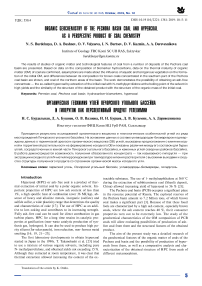Organic geochemistry of the Pechora basin coal and hypercoal as a perspective product of coal chemistry
Автор: Burdelnaya N.S., Bushnev D.A., Valyaeva O.V., Burtsev I.N., Kuzmin D.V., Derevesnikova A.A.
Журнал: Вестник геонаук @vestnik-geo
Рубрика: Научные статьи
Статья в выпуске: 10 (298), 2019 года.
Бесплатный доступ
The results of studies of organic matter and technological features of coal from a number of deposits of the Pechora coal basin are presented. Based on data on the composition of biomarker hydrocarbons, data on the thermal maturity of organic matter (OM) of coal are confirmed, assumptions are made about the influence of aquatic and terrigenous vegetation on the formation of the initial OM, and differences between its composition for brown coals concentrated in the southern part of the Pechora coal basin are shown, and coal of the northern areas of the basin. The work demonstrates the possibility of obtaining an ash-free concentrate - the so-called hypercoal by extraction of the initial coal with N-methylpyrrolidone at the boiling point of the solvent in high yields and the similarity of the structure of the obtained product with the structure of the organic mass of the initial coal.
Permian coal, pechora coal basin, hydrocarbon-biomarkers, hypercoal
Короткий адрес: https://sciup.org/149129349
IDR: 149129349 | УДК: 550.4 | DOI: 10.19110/2221-1381-2019-10-5-11
Текст научной статьи Organic geochemistry of the Pechora basin coal and hypercoal as a perspective product of coal chemistry
Hypercoal (HPC) or ash-free coal is a product of thermal extraction of initial coal by a polar organic solvent. Important properties of HPC are low ash content of less than 1%, a high specific heat of combustion (over 36 MJ/kg), absence of heavy and alkaline metals, inorganic (sulfate) and sulfide sulfur, a wide plasticity range that determines the quality and characteristics of coke [17]. The use of HPC as an additive to low-coking coal contributes to its increasing strength. Fully ash-free coal can be used for direct combustion in gas turbine plants. HPC for a long time retains its catalytic properties at gasification (non-waste catalytic production of synthesis gas, hydrogen). It can also be used to produce high purity silicon (for solar panels), iron reduction, non-ferrous metal smelting [16, 19, 21—23].
The first laboratory developments to obtain hypercoal started in Japan in the 1990s. T. Takanohashi et al. [23] tried to use a mixture of various organic solvents, including pure N-methylpyrrolidone, and obtained yields not exceeding 15 %. Although they extracted at room temperature, it was clear that thermal extraction allowed increasing the content of the ex- tractable substance. The use of 1-methylnaphthalene at 360 °C during the extraction of subbituminous coal (Shenfu deposit, China) allowed increasing yield of hypercoal to 56 % [21].
The Pechora coal basin (PCB) occupies a significant place in the resource potential of Russia. The explored reserves of the Pechora basin amount to 7.2 billion tons, of which brown coal makes a significant part [3]. Because of that these fossil fuels are characterized by a high ash content, especially brown coals, where the ash content reaches 40 %, their consumer properties turn out to be extremely low. The study of the geochemical characteristics of the OM composition of PCB coals will allow evaluating possibilities of production of ashfree coal from them and the structural features of the obtained product.
The aim of the present study was a detailed research of the geochemical features of the organic matter of coals of the Pechora coal basin and the possibility of production of hypercoals from them, as well as a comparative analysis and characterization of the obtained structure of HPC from coals of different metamorphism.
Translation of the article by K. Ordin.
Table 1. The main data of coals of the Pechora coal basin
Таблица 1. Основные данные углей Печорского угольного бассейна
|
Месторождение/пласт / Dcposit/scam Нечепское / Nechenskoe Интинское/пласт 10/8 / Intinskoe/seam 10/8 Интинское/пласт 10/12 / Intinskoe/seam 10/12 Интинское/пласт 11/10 / Intinskoe/seam 11/10 Ворт ашорское/ш. Воргашорская, пласт Мощный Vorgashorskoe/Vorgashorskaya mine, Moshchny seam Воркутское/ш. Октябрьская, пласт Мощный Vorkutskoe/Oktyabrskaya mine, Moshchny seam Воркутское/ш. Комсомольская, пласт Мощный Vorkutskoe/Komsomolskaya mine, Moshchny seam Юпьягипское / Yunyaginskoe Верхнесырьягинское / Verkhnesyryaginskoe |
Возраст / Age P2pc P,in P,in P,ln P|Td/P2in P,rd/P2in P,rd/P2in P,rd P,rd/P2in |
Марка / Rank brown r D coal Б / B Б/Д /B/LF Б/Д / B/LF Б/Д / B/LF _ ДЖ / LFF о ГЖ / GF ГЖ / GF K/C T/G |
c , %’ 36.5 53.4 54.0 54.4 78.3 79.4 81.0 64.8 64.5 |
At, % 18.5 16.9 17.0 14.2 6.6 6.2 5.6 9.0 20.6 |
Выход ГПУ, % Hypcrcoal yield, % 4 17 11 13 16.3 20.0 32.5 17.0 24.0 (+раствори тель/ solvent) |
Materials and research methods
Coals of Nechenskoe, Inta, Vorkuta, Vorgashor, Verkh-nesyryaga and Yunyaga deposits represented by rank B, D, Zh, K and T, respectively, were used in the study (Table 1).
Coal samples characterized by high ash content were enriched in a liquid with a density of 1.6 g/m3. To obtain ashfree coal or HPC, a sample of enriched coal weighing about 30 g was used and treated with 300 ml of N-methylpyrroli-done (NMP) at the boiling point of the solvent. After distillation of the solvent, the resulting precipitate was dried at a temperature of 230 °C, then washed with hot water and dried at a temperature of 140 °C, and then stored for further studies [5]. The yields, ash content, and elemental composition were de- termined for the initial coals and HPC and coal residues obtained from them. 13C CP/MAS NMR spectra were obtained for coal before and after NMP extraction [5, 6]. For a number of samples, thermogravimetric analysis was carried out, pyrolysis of samples at 420 °C in an argon flow, further pyrolysis products were analyzed by gas chromatography/mass spectrometry [4].
Results and its discussion
The Pechora coal basin features coals of various ranks from the onset of brown coal stage to anthracites (Fig. 1). Regional metamorphism proceeded at various rates. In the northwest, the thickness of catagenesis zones is 1 .5—
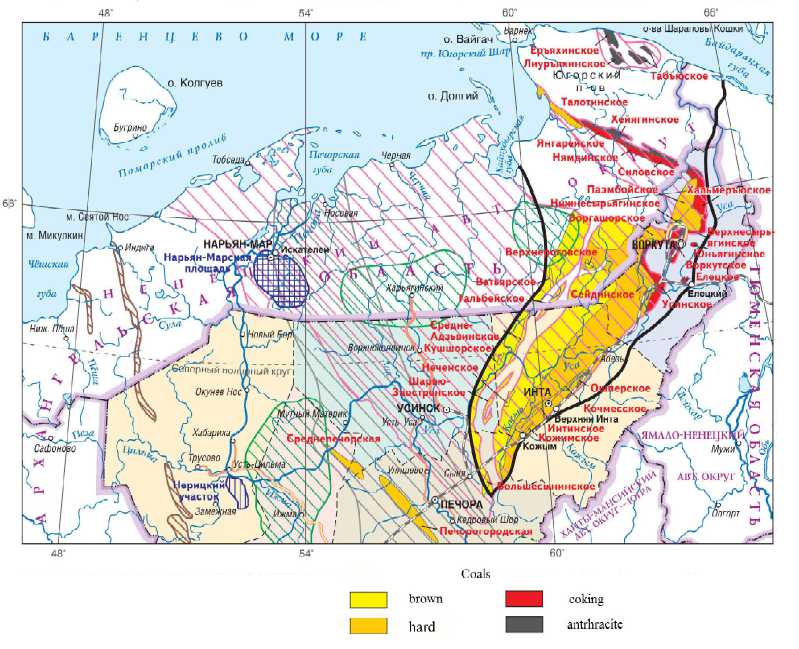
Fig. 1. Deposits of the Pechora coal basin [3]
Рис. 1. Месторождения Печорского yгoёь^oгo бассей^а [3]
2 times less than in the east. Three types of catagenetic sections are distinguished, which differ by the growth rate and thickness of the catagenesis zones: extended with a low growth catagenesis gradient, medium and shortened with an increased gradient [9]. In the south of PCB mainly brown coals are concentrated, in the northern part of the basin — hard and anthracites.
Organic geochemistry of PCB initial coals
Brown coals of the Nechenskoe deposit are characterized on average by lower Corg than coals of the Inta deposit and more mature coals of Vorkuta regions (Table 1). The values of Corg in brown coal itself vary from 27 (matte coal) to 60 % (glance coal) [10], in the studied Inta coals — on average from 44 to 54 % [5], in hard coals of Vorkuta region — 74.7—81 % [6].
The composition of the hydrocarbon fraction of bitumoid of the studied coals indicates a significant contribution of a humus component to the initial biomass of coal. Firstly, this is confirmed by a high content of odd n- alkanes in the high molecular region (Fig. 2, A, C, D), and secondly, by significant concentrations of C29 sterane, which is an important indicator reflecting the terrygenous genesis (Fig. 3) [20]. Thirdly, the composition of the aromatic fraction of bitumoid clearly proves the presence of a terrigenous component containing remains of coniferous and herbaceous vegetation [6]. Thus, retene, methylretene, formed at the final stage during the diagenetic conversion of abietic acid, which is a part of the resin of conifers, dominate among OM aromatic compounds of the Vorkuta region coals, while in the Inta coals, along with retene and intermediate products of conversion of abietic acid (simo-nellite and dehydroabietane) cadalene is present, found in many herbaceous plants, fungi, bryophytes, and a number of other sources [15]. The obtained data do not contradict the petrographic composition of the studied coals [3, 10, 11].
An interesting feature of the hydrocarbon composition of Permian bitumen coals of the Pechora coal basin is the different ratio of normal alkanes to acyclic isoprenoid alkanes (Fig. 2) (Table 2). For example, isoprenanes are practically absent in the brown coal bitumen of the Nechenskoe deposit — Pr+Ph/ и- C 17 + и- C 18 ratio varies from 0.09 to 0.46 [8]. It would seem that these coals are in the initial series of thermal transformations, i.e. are the most immature among Permian coal from PCB (analysis of coal samples showed that the vitrinite reflectance Ro does not exceed 0.41 % and corresponds to the brand of brown coals), and probably could not release some of isoprene structures. Nevertheless, an experiment with water pyrolysis of Nechenskoe brown coals at 300 °C showed insignificant changes in (Pr+Ph/ и- C 17 + и- C18) ratio, varying from 0.26 to 0.54 (Fig. 2, A and B) [2], i. e. remaining within the limits of the unconverted OM of coal [8]. It is likely that such a low content of isoprenanes in the coals of the Nechen-skoe deposit is resulted from some difference in the composition of the initial plant material of these coals relative to other PCB coals. According to the data [11], OM accumulation of coals of the Nechenskoe deposit proceeded in peat bogs, sometimes accompanied by formation of stagnant environment at changing anaerobic-aerobic conditions.
The insignificant contribution of aquatic vegetation to the total initial biomass of the studied coals is also confirmed by
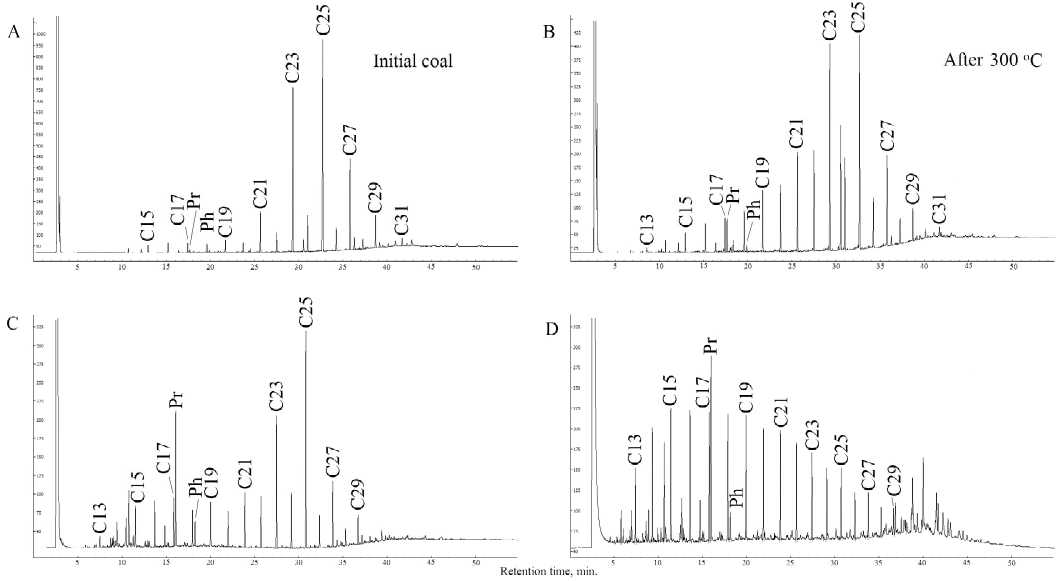
Fig. 2. Gas-chromatography distribution of n- and iso- alkanes of the hydrocarbon fraction of Permian coal bitumoids of the Pechora coal basin: A, B — of the Nechensky deposit before and after hydrous pyrolysis at 300 °C, respectively, C — of the Intinsky deposit, D — of the Vorkutsky deposit
Рис. 2. Газохроматографическое распредеёе^ие н - и изо -азкаиов yгёeвoдopoд^oй фракции битумоидов пермских угёей Печорс-êîãî óãîëüíîãî áàññåéíà: À, B — Íå÷åíñêîãî ìåñòîðîæäåíèÿ äî è ïîñëå âîäíîãî ïèðîëèçà ïðè 300 °Ñ ñîîòâåòñòâåííî, C — Èíòèí-ñêîãî ìåñòîðîæäåíèÿ, D — Âîðêóòñêîãî ìåñòîðîæäåíèÿ
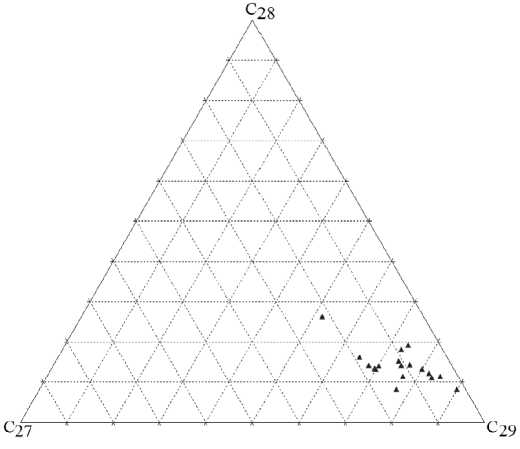
Fig. 3. Triangular distribution diagram of the composition C27—C29 steranes of the hydrocarbon fraction of Permian coal bitumoids of the Pechora coal basin
Рис. 3. Треугоёь^ая диаграмма pacпpeдeёe^ия стера^ов состава Ñ27—Ñ29 óãëåâîäîðîäíîé ôðàêöèè áèòóìîèäîâ ïåðìñêèõ óãëåé Ïå÷îðñêîãî óãîëüíîãî áàññåéíà the data on the distribution of n-alkanes, where the main maximum falls on n-alkanes of C23—C25 composition [5, 6, 8, 11]. As a rule, n-alkanes of C21, C23 and C25 composition can belong to vascular plants, microalgae, sphagnum, etc. [14, 18]. Coal bitumoids from the Vorkuta region are characterized by a more pronounced dominance of n-alkanes of C21—C25 composition [6].
The lithological studies of PCB coal deposits, in particular, the Inta formation of the Inta coal region, allowed the authors [12] to make an assumption about the formation of swamp peatlands and lakes of different sizes in the Pechora Basin, which resulted in the formation of coals of different OM composition.
Based on the results of the analysis of polycyclic hydrocarbon biomarkers, we evaluated the degree of OM thermal conversion of coals [5, 6, 8]. By the presence of biological forms of β β hopanes, unsaturated pentacyclic terpanes — neo-hop13(18)-enes of C29 and C30 composition, as well as low values of 22S/22S+R ratio calculated by ααα Ñ29 sterane, and 22S/22S+R ratio calculated by αβ Ñ31 hopane (Table 2), we determined that the maturity of the organic matter of coals from Nechenskoe and Inta deposits was small and corresponded to the end of protocatagenesis. For OM of these coals, it was significantly lower than the thermal maturity of OM of the coals from Syryaga, Vorkuta, and Vorgashor deposits of PCB. In the latter case, OM catagenesis reaches MC2 grade — onset of MC3 [2, 7], which is concordant with the reconstruction of the paleogeothermal regime of Permian strata of PreUral Foredeep carried out earlier by L. A. Anishchenko et al. [1, 9].
Production of ash-free coals
After NMP treatment we received hypercoals with an ash content of less than 1 %. The yield of the extract ranges from 4 to 30 %. The minimum HPC yield is characteristic of brown coal of the Nechenskoe deposit. Inta coals also give low extract yields, the metamorphism of which is low. The highest yield of the extract was obtained at processing gas fat coals.
To study the structural features of the initial coals, HPC and coal residues, we used thermogravimetric analysis (TGA), examined 13C NMR spectra, and carried out off-line pyrolysis of the samples.
TGA curves, obtained for the initial coal-hypercoal-coal residue series, indicate that the greatest weight loss upon heating turned out to be characteristic of hypercoals (up to 35 %) (Fig. 4). In the range of 400—500 °C, so-called active pyroly-
Table 2. Geochemical characteristics of the hydrocarbon fraction of coal bitumen of the Pechora coal basin by GC and GC/MS Таблица 2. Геохимическая характеристика углеводородной фракции битумоида углей Печорского угольного бассейна по данным ГЖХ и ХМС
|
Месторождение Deposit |
Образец / Sample |
copr, % |
Pr+Ph/ C|7+C18 |
20S/20S+R С29-стерап / C29-sterane |
22S/22S+R Сзггопап / C3rhopane |
|
Неченское Nechenskoe |
Уголь блестящий, скв. 408, № 14 Bright coal, borehole 408, No. 14 |
42.40 |
0.30 |
0.07 |
0.13 |
|
Уголь полумаговый, скв. 408, № 42 Semi-dull coal, borehole 408, No. 42 |
27.80 |
0.21 |
0.07 |
0.13 |
|
|
Уголь полосчатый, скв. 408, № 52 Banded coal, borehole 408, No. 52 |
52.40 |
0.46 |
0.12 |
0.17 |
|
|
Уголь полублестящий, скв. 408, № 57 Semi-bright coal, borehole 408, No. 57 |
48.70 |
0.25 |
0.02 |
0.12 |
|
|
Интинское Intinskoe |
10/8 |
53.40 |
1.81 |
0.07 |
0.19 |
|
10/12 |
54.00 |
1.53 |
0.06 |
0.17 |
|
|
11/10 |
54.40 |
1.70 |
0.04 |
0.15 |
|
|
11/18 |
44.30 |
2.15 |
0.05 |
0.15 |
|
|
Сырьягинское Syryaginskoe |
SYR-6-1 |
50.87 |
1.18 |
0.37 |
0.58 |
|
SYR-8-2/1 |
41.10 |
1.80 |
0.46 |
0.60 |
|
|
Воргашорское Vorgashorskoe |
пласт Мощный, 30—60 см от подошвы Moshchny seam, 30—60 cm from base |
78.28 |
1.56 |
0.45 |
0.60 |
|
пласт Мощный, 120—150 см от подошвы Moshchny seam, 120— 150 cm from base |
74.70 |
4.41 |
0.39 |
0.59 |
|
|
пласт Мощный, 180—200 см от подошвы Moshchny seam, 180—200 cm from base |
76.27 |
1.59 |
0.46 |
0.59 |
|
|
Воркутское Vorkutskoe |
ш. Октябрьская / Oktyabrskaya mine |
79.41 |
1.00 |
0.46 |
0.58 |
|
ш. Комсомольская / Komsomolskaya mine |
81.00 |
0.38 |
0.42 |
0.59 |
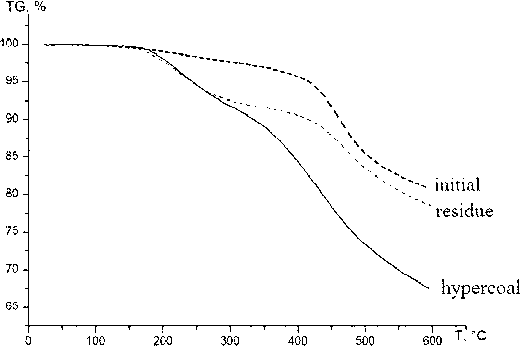
Fig. 4. TGA curves coal, hypercoal and coal residue from mine Komsomolskaya (Vorkutsky deposit)
Ðèñ. 4. Êðèâûå ÒÃÀ óãëÿ, ÃÏÓ è óãîëüíîãî îñòàòêà èç ø. Êîì-ñîìîëüñêîé (Âîðêóòñêîå ìåñòîðîæäåíèå)
sis occurs, at which a sharp decomposition of OM of the coals occurs, followed by passive pyrolysis at a higher temperature, at which a long-term thermal decomposition takes place. The decomposition of HPC starts much earlier than coal and occurs stepwise, which may be due to the extraction of various structural blocks during extraction. Residual coal is characterized by a more gradient weight loss [4].
Solid-state 13C NMR spectroscopy for the initial coals, HPC, and coal residue showed the presence of two broad bands related to aliphatic carbon (10—40 ppm range) and aromatic carbon (100—150 ppm range). As can be seen from the spectra, aromatic structures dominate in the structure of the studied coals, and the higher the stage of coalification, the lower the ratio of aliphatic carbon to aromatic carbon (Fig. 5). Analysis of 13C NMR spectra indicates that the structure of the hypercoals is rather similar to the initial coals. Moreover, they are characterized by a slight increase of the aliphatic component and the presence of amido groups due to interaction with the solvent. The spectra of the residual part of the coal after extraction also indicate the dominance of aromatic component of coal organic mass. Schematically, the image of the hypothetical structure (structural unit) of HPC, obtained during the extraction of the initial NMP coal, can be represented as follows (Fig. 6). A polar solvent penetrates the structure of coal and breaks the hydrogen bonds inside the matrix of coal organic mass, while new hydrogen bonds arise between the solvent and the structural components of coal. Unfortunately, the presented model does not reflect real structural fragments of Permian coals. Nevertheless, it quite clearly reflects the “aromatic” essence of OM coals as a whole, and also explains the effect of the polar solvent and production of hypercoals.
The pyrolysis of coal and its products by solvent, carried out off-line at 420 °C in argon atmosphere, showed that the main components of the pyrolyzate were n- alkanes and n- alk-enes-1, the aromatic components were represented by alkylsubstituted benzenes, naphthalenes, phenanthrenes, dibenzofurans and biphenyls [4]. We calculated yields of sums of n- alkanes, alkylnaphthalenes and alkylphenanthrenes. The yield of phenanthrenes for a series of coal — HPC — residue is maximal for the hypercoal and minimal for the residue. The yield of both n -alkanes and naphthalenes for the coal residue is lower than for the initial coal and the hypercoal extracted from it. The analysis of ratios of n- alkanes/naphthalenes, n- alkanes/phenanthrenes and naphthalenes/phenanthrenes allowed determining that, in comparison with the precursor structures of n -alkanes and naphthalenes, the precursor struc-
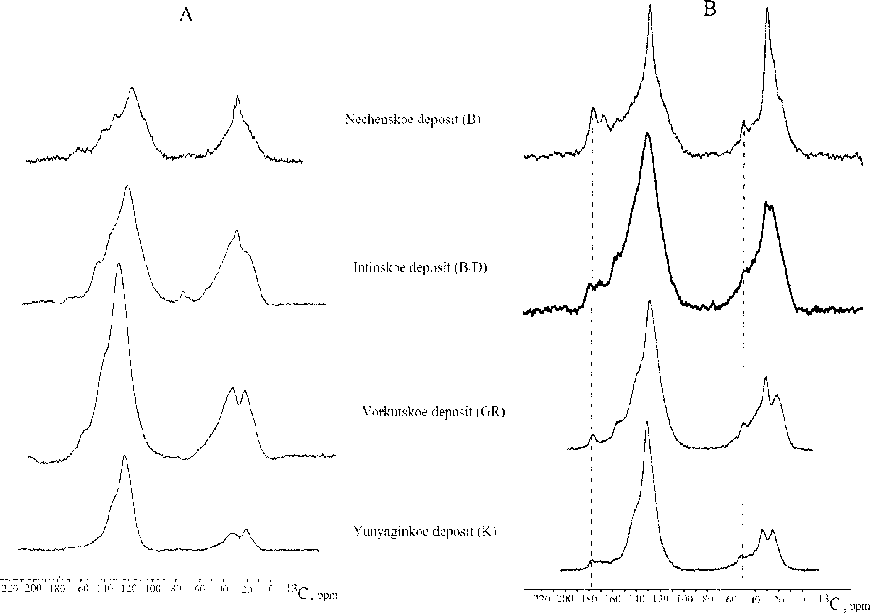
Fig. 5. 13C NMR-spectra: A — of the initial coals of Pechora coal basin, B — hypercoals
Ðèñ. 5. 13Ñ ßÌÐ-ñïåêòðû: A — èñõîäíûõ óãëåé ÏÓÁ, B — ãèïåðóãëåé
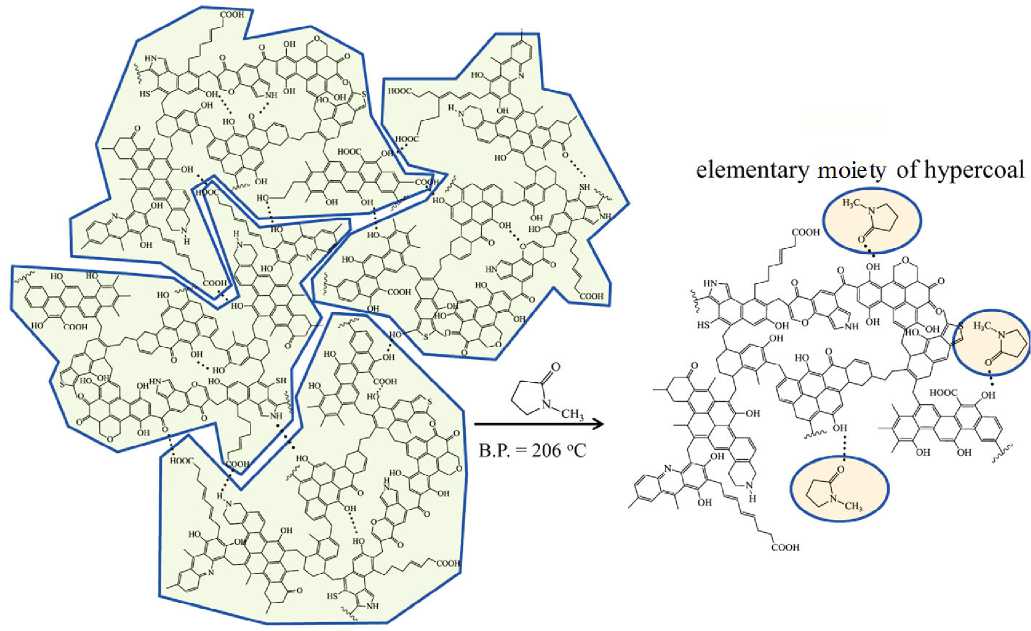
Fig. 6. Formation of the elementary moiety of hypercoal (fragment of the chemical structure of coal vitrinite is taken from the work [13])
Ðèñ. 6. Îáðàçîâàíèå ýëåìåíòàðíîãî çâåíà ãèïåðóãëÿ (ôðàãìåíò õèìè÷åñêîé ñòðóêòóðû âèòðèíèòà óãëÿ [13])
tures of phenanthrenes are transferred to HPC composition during coal extraction with N-methylpyrrolidone. In coal, HPC and residue, the precursors of naphthalenes and n- al-kanes are in equal proportions. The obtained results suggest that extraction with N-methylpyrrolidone with greater efficiency transfers substantially aromatic components of initial coal to HPC composition, and the transfer efficiency of aliphatic fragments is lower.
Conclusion
Thus, studies of the hydrocarbon composition of Permian coal bitumoids from the Pechora coal basin showed that the main component of their initial biomass was the remains of higher vegetation represented by mass of conifers and herbaceous plants. At that algal components, also in the initial OM of coal, played an important role in the formation of the coals, especially in the northern areas of the Pechora basin. The analysis of polycyclic biomarkers confirmed patterns of catagenetic transformation of OM of the coals of the basin revealed earlier [9], where it was shown that coals with extremely low OM maturity were concentrated in the southern part of PCB, while OM maturity in the northern part of the basin is significantly higher and corresponds to MC2-3 grades.
The geochemical features of OM composition of the coals affected the production of ash-free coals. Thus, low HPC yields were obtained from higher ash, rebellious immature coals from PCB, characterized by a heterogeneous, predominantly vitrinite composition and strong OM oxidation. It is possible that to increase yield of the extract from brown coals of the Nec-henskoe deposit and long-flame coals of the Inta deposit, it is necessary to change the technology of HPC production by increasing the temperature of its extraction. On the whole, the structure of the produced hypercoals has a certain similarity with the structure of the initial coal; therefore, it is likely that after processing by an organic solvent, coals of the same type of structure will be obtained without mineral impurities.
Analytical studies are partially carried out at CCU Geonauka.
The authors are grateful to Cand. Sc. (geol.-miner.) S. V. Ryabinkin (IG Komi SC UB RAS, Syktyvkar) for kindly provided coal samples from the Vorkuta region, Cand. Sc. (chemistry) V.A.Belyi (IC Komi SC UB RAS, Syktyvkar) for thermogravi-metric analysis of the samples, M. V. Mokeev (Institute of Macromolecular Compounds RAS, St. Petersburg) for 13C NMR spectra.
This work was partly supported by UB RAS programs «Pro-spective ore regions of the north of the Urals, Pay-Khoy and Ti-man» (project No. 18-5-5-57, GR. No. AAAA-A17-117121140076-3), «Resource-industrial and infrastructural transformation as a factor in the development of the Vorkuta support zone of the Russian Arctic» (No. 18-9-5-42, ÃÐ. ¹ ÀÀÀÀ-À17-117121140075-6).
Список литературы Organic geochemistry of the Pechora basin coal and hypercoal as a perspective product of coal chemistry
- Anishchenko L. A., Klimenko S. S., Ryabinkina N. N. Organicheskoye veshchestvo permskikh otlozheniy Pechorskogo ugol'nogo basseyna (Organic matter of Permian deposits of the Pechora coal basin). Trudy Instituta geologii Komi NTS UrO RAN, 2002, 11, pp. 91-109.
- Burdel'naya N. S., Bushnev D. A., Mokeyev M. V. Izmeneniya sostava bitumoida i khimicheskoy struktury kerogena pri gidrotermal'nom vozdeystvii na porodu (Changes in the composition of bitumen and the chemical structure of kerogen under hydrothermal effects on the rock). Geokhimiya, 2013, No. 9, pp. 819-833.
- Burtsev I. N., Saldin V. A., Iyevlev A. A., Anishchenko L. A., Prots'ko O.S. i dr. Buryye ugli - perspektivnyy resurs dlya sozdaniya novykh otrasley promyshlennosti v Timano-Severoural'skom regione (Brown coal is a promising resource for creating new industries in the Timan-Northern Ural region). Vestnik of Institute of geology Komi SC UB RAS, 2012, No. 10, pp. 26-31.
- Bushnev D. A., Burdel'naya N. S., Kuz'min D. V., Valyayeva O. V., Derevesnikova A. A., Belyy V. A. Khimicheskaya struktura ugley vorkutinskogo rayona i vydelennykh iz nikh giperugley po dannym analiticheskogo piroliza (The chemical structure of coals of the Vorkuta region and the hypercoals extracted from them according to analytical pyrolysis). Vestnik of Institute of geology Komi SC UB RAS, 2018, No. 284, pp. 8-12.
- Bushnev D. A., Burdel'naya N. S., Kuz'min D. V., Mokeyev M. V., Burtsev I. N. Biomarkery ugley Intinskogo mestorozhdeniya, vydeleniye i analiz khimicheskoy struktury giperugley (Coal biomarkers of the Intinsky deposit, isolation and analysis of the chemical structure of hypercoals). Vestnik of Institute of geology Komi SC UB RAS, 2016, No. 11, pp. 17-24.

